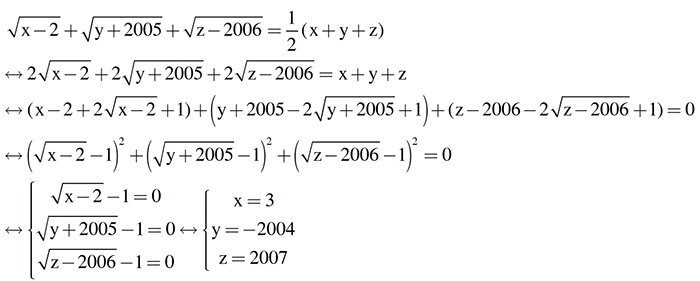Hãy nhập câu hỏi của bạn vào đây, nếu là tài khoản VIP, bạn sẽ được ưu tiên trả lời.

C = ..................................................................... ( giống cái đề bài )
= ( x + 2017 ) + ( x + 2018 ) + ( x + 2019 )
= ( x + x + x ) + ( 2017 + 2018 + 2019 )
= 3x + 6054
Vì ( x + 2017 ) là căn bậc 2 của ( x+2017 )^2 => x+2017 > hoặc = 0
( x + 2018 ) ........................... ( x+2018)^2 => x+2018 > hoặc = 0
( x + 2019) ............................( x+2019 )^2 => x+2019 > hoặc = 0
SUY RA ( x+2017 ) + ( x+2018 ) + ( x+2019 ) > hoặc = 0 => 3x + 6054 > hoặc = 0
dấu đẳng thức xảy ra <=> 3x + 6054 = 0 <=> 3x = - 6054 <=> x = - 2018
Vậy C có GTNN là 0 khi x = - 2018

Bài này cô cũng nghĩ là dùng phương pháp toa độ, chuyển qua hình học giải tích Oxy để giải.
Cô làm như sau:
Từ biểu thức P ta nghĩ đến công thức tính khoảng cách giữa hai điểm. Từ đó ta đặt \(A\left(-1;1\right);B\left(1;-1\right);C\left(-2;-2\right)\) và \(D\left(x;y\right)\). Khi đó ta thấy ngay \(P\left(x;y\right)=DA+DB+DC\)
Ta vẽ các điểm trên trục tọa độ:
Vậy điểm D cần tìm là điểm tạo với các cạnh tam giác góc 120o. (Để hiểu rõ thêm e có thể đọc về điểm Toricenli của tam giác ABC). Do tam giác ABC cân tại C nên D thuộc CO, nói cách khác xD = yD.
Do \(\widehat{ADB}=120^o\Rightarrow\widehat{ADO}=60^o.\) Vậy thì \(tan60^o=\sqrt{3}=\frac{OA}{DO}\)
Do \(OA=\sqrt{2}\Rightarrow DO=\frac{\sqrt{2}}{\sqrt{3}}=\sqrt{\frac{2}{3}}\)
Vậy \(\sqrt{x_D^2+y_D^2}=\sqrt{2y_D^2}=\sqrt{\frac{2}{3}}\Rightarrow\left|x_D\right|=\left|y_D\right|=\frac{1}{\sqrt{3}}\). Từ hình vẽ ta có: \(x_D=y_D=-\frac{1}{\sqrt{3}}.\)
Vậy \(P\left(x;y\right)=DA+DB+DC=\sqrt{\left(-\frac{1}{\sqrt{3}}+1\right)^2+\left(-\frac{1}{\sqrt{3}}-1\right)^2}\)
\(+\sqrt{\left(-\frac{1}{\sqrt{3}}-1\right)^2+\left(-\frac{1}{\sqrt{3}}+1\right)^2}+\sqrt{\left(-\frac{1}{\sqrt{3}}+2\right)^2+\left(-\frac{1}{\sqrt{3}}+2\right)^2}\)
\(=\sqrt{6}+2\sqrt{2}.\)
Vậy min P(x;y) = \(\sqrt{6}+2\sqrt{2}\) khi \(x=y=-\frac{1}{\sqrt{3}}.\)

Lời giải:
ĐKXĐ: $x\geq 0; x\neq 1$
\(P=\frac{x+\sqrt{x}-(x+2)}{\sqrt{x}+1}:\left[\frac{\sqrt{x}(\sqrt{x}-1)}{(\sqrt{x}+1)(\sqrt{x}-1)}+\frac{\sqrt{x}-4}{(\sqrt{x}-1)(\sqrt{x}+1)}\right]\)
\(=\frac{\sqrt{x}-2}{\sqrt{x}+1}:\frac{x-\sqrt{x}+\sqrt{x}-4}{(\sqrt{x}-1)(\sqrt{x}+1)}\)
\(=\frac{\sqrt{x}-2}{\sqrt{x}+1}:\frac{x-4}{(\sqrt{x}-1)(\sqrt{x}+1)}=\frac{\sqrt{x}-2}{\sqrt{x}+1}.\frac{(\sqrt{x}-1)(\sqrt{x}+1)}{(\sqrt{x}-2)(\sqrt{x}+2)}\)
\(=\frac{\sqrt{x}-1}{\sqrt{x}+2}=1-\frac{3}{\sqrt{x}+2}\)
Với mọi $x\geq 0; x\neq 1$ thì $\sqrt{x}+2\geq 2$
$\Rightarrow \frac{3}{\sqrt{x}+2}\leq \frac{3}{2}$
$\Rightarrow P=1-\frac{3}{\sqrt{x}+2}\geq 1-\frac{3}{2}=\frac{-1}{2}$
Vậy $P_{\min}=\frac{-1}{2}$ khi $x=0$

a: \(P=\left(\dfrac{2+\sqrt{x}-1}{\left(\sqrt{x}-1\right)\left(\sqrt{x}+1\right)}\right):\dfrac{\sqrt{x}+1-\sqrt{x}}{\sqrt{x}+1}\)
\(=\dfrac{1}{\sqrt{x}-1}\cdot\dfrac{\sqrt{x}+1}{1}=\dfrac{\sqrt{x}+1}{\sqrt{x}-1}\)
b: Để P nguyên thì \(\sqrt{x}+1⋮\sqrt{x}-1\)
\(\Leftrightarrow\sqrt{x}-1\in\left\{-1;1;2\right\}\)
hay \(x\in\left\{0;4;9\right\}\)

\(\sqrt{\left(x+1995\right)^2}+\sqrt{\left(x+1996\right)^2}=\left|x+1995\right|+\left|x+1996\right|\)
\(=\left|-x-1995\right|+\left|x-1996\right|\)
Ta chứng minh Bđt \(\left|a\right|+\left|b\right|\ge\left|a+b\right|\)
\(\Leftrightarrow\left(\left|a\right|+\left|b\right|\right)^2\ge\left(\left|a+b\right|\right)^2\)
\(\Leftrightarrow a^2+b^2+2\left|ab\right|\ge a^2+b^2+2ab\)
\(\Leftrightarrow\left|ab\right|\ge ab\) luôn đúng
Dấu = khi \(ab\ge0\)
\(\Rightarrow\left|-x-1995\right|+\left|x+1996\right|\ge\left|-x-1995+x+1996\right|=1\)
Dấu = khi \(\left(x+1995\right)\left(x+1996\right)\ge0\)\(\Rightarrow1995\le x\le1996\)
\(\Rightarrow\hept{\begin{cases}1995\le x\le1996\\\left(x+1995\right)\left(x+1996\right)=0\end{cases}}\Leftrightarrow\hept{\begin{cases}x=-1995\\x=-1996\end{cases}}\)